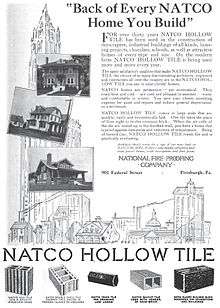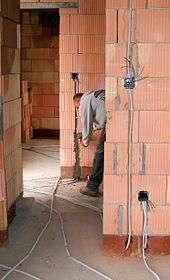Structural clay tile

Structural clay tile describes a category of burned-clay building materials used to construct the walls of buildings and in structural fireproofing. Also called building tile, structural terra cotta, hollow tile, and clay block, the material is an extruded clay shape with substantial depth that allows it to be laid in the same manner as other clay or concrete masonry. In North America it was chiefly used during the late 19th and early 20th centuries, and continues to be used in Europe to build fire-resistant walls and partitions. While most such units were intended to be covered with plaster or a similar finish material, structural glazed facing tiles (SGFT) have a glazed finish on one or more sides and are used as finish materials. In North America the material has largely been replaced by concrete masonry units.
Clay tile units
Hollow clay tile units were introduced in North America after 1875 for use as a lightweight, fire-resistant system for the construction of partitions in steel-framed buildings. Tile is classified into load-bearing and non-load-bearing categories. Load-bearing tile is described under ASTM Standard C34, subdivided into grade LBX, for areas exposed to weathering, and LB, for protected applications. Non-load-bearing tile is described under ASTM C56 in one grade, NB. It is used for interior partitions, and may be laid with cells running horizontally or vertically. Tile may be ribbed to accept a plaster finish, or smooth. Special shapes were available to attach to and to fit around structural steel shapes, providing a fire-resistant enclosure for the load-bearing steel members.[1][2]

Structural clay tiles are manufactured in a variety of standard sizes, including 4", 6", 8", 10" and 12" thicknesses, and typically 12" x 12" or 12" x 8" face dimensions.[1] Tile was also manufactured in a series of graduated wedge shapes for installation between steel members as a fireproof flat arch floor structure, to be covered with a concrete wearing surface above. In other cases, structural clay tile was used as a permanent form material to reduce the bulk and weight of structural concrete floor slabs.[3]
Specialized kinds of structural clay tile were produced with a vitrified or glazed curved surface for use in building farm silos. Other shapes, called "telephone tiles", were used as underground multi-celled conduits for telephone cables..[4]
Structural glazed facing tile
Structural glazed facing tile has been extensively used in institutional settings where a durable, easily cleanable surface is desired. The material is commonly found in schools, correctional facilities, swimming pools and similar facilities. A wide variety of shapes have been developed to allow the construction of corners, caps, wall base and other elements using standard sizes. SGFT cannot be easily cut without damage to the glazed surface, so several dozen special shapes are available to allow most situations to be accommodated. SGFT features a fired glazed surface that may be produced in colors similar to those available from standard ceramic tile.[1] SGFT has been replaced in some applications by glazed masonry units, a composite of concrete masonry and a tile-like surface coating.
See also
References
- 1 2 3 Beall, Christine (1987). Masonry Design and Detailing for Architects, Engineers and Builders. McGraw-Hill. pp. 45–52. ISBN 0-07-004223-3.
- ↑ Ramsey, Charles George; Sleeper, Harold Reeve (1951). Architectural Graphic Standards (Fourth ed.). John Wiley & Sons. pp. 30–33.
- ↑ Kibbell, William III. "Structural Terra Cotta". Historic Buildings. Retrieved 7 December 2011.
- ↑ Kibbell, William III. "Telephone Tile and Silo Tile". Historic Buildings. Retrieved 7 December 2011.
| Wikimedia Commons has media related to Clay block bricks. |